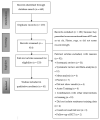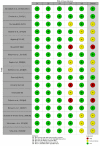Resistance Training in Breast Cancer Survivors: A Systematic Review of Exercise Programs
- PMID: 32906761
- PMCID: PMC7558202
- DOI: 10.3390/ijerph17186511
Resistance Training in Breast Cancer Survivors: A Systematic Review of Exercise Programs
Abstract
The aim of this study was to identify the characteristics of resistance training (RT) programs for breast cancer survivors (BCS). A systematic review of the literature was performed using PubMed, Medline, Science Direct, the Cochrane Breast Cancer Specialised Register of the Cochrane Library, the Physiotherapy Evidence Database (PEDro), and Scopus, with the aim of identifying all published studies on RT and BCS from 1 January 1990 to 6 December 2019, using the Preferred Reporting Items for Systematic Reviews and Meta-Analyses (PRISMA) guidelines. The risk of bias in the studies was assessed using the revised Cochrane Risk of Bias tool (RoB 2.0). Sixteen trials were included for qualitative analysis. More than half of the trials do not adequately report the characteristics that make up the exercise program. The maximal strength was the most frequently monitored manifestation of strength, evaluated mainly as one-repetition maximum (1RM). Resistance training was performed on strength-training machines, twice a week, using a load between 50% and 80% of 1RM. The trials reported significant improvement in muscle strength, fatigue, pain, quality of life, and minor changes in aerobic capacity.
Keywords: breast neoplasms; exercise prescriptions; lymphedema; physical function; quality of life; strength.
Conflict of interest statement
The authors declare no conflict of interest.
Figures
References
Publication types
MeSH terms
LinkOut - more resources
Full Text Sources
Medical



